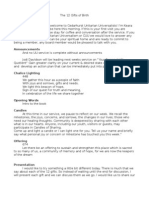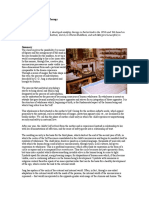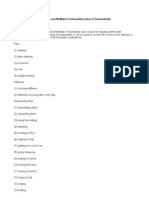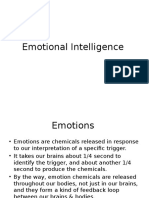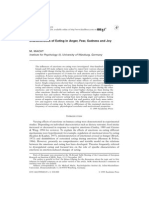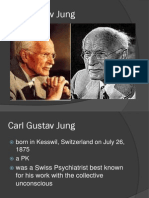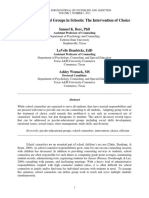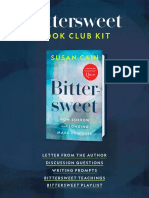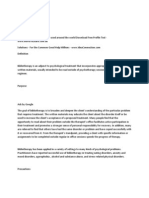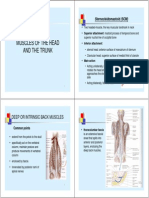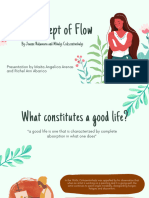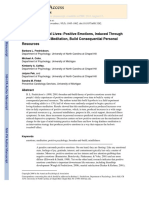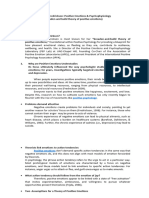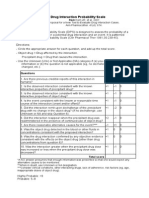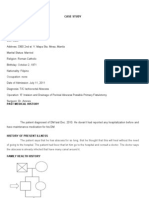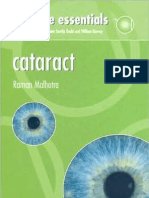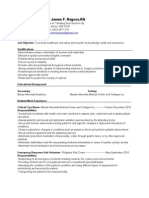Positive Emotions Trigger Upward Spirals Toward Emotional Well-Being
Positive Emotions Trigger Upward Spirals Toward Emotional Well-Being
Uploaded by
Olga MendozaCopyright:
Available Formats
Positive Emotions Trigger Upward Spirals Toward Emotional Well-Being
Positive Emotions Trigger Upward Spirals Toward Emotional Well-Being
Uploaded by
Olga MendozaCopyright
Available Formats
Share this document
Did you find this document useful?
Is this content inappropriate?
Copyright:
Available Formats
Positive Emotions Trigger Upward Spirals Toward Emotional Well-Being
Positive Emotions Trigger Upward Spirals Toward Emotional Well-Being
Uploaded by
Olga MendozaCopyright:
Available Formats
Psychological Science
http://pss.sagepub.com/
Positive Emotions Trigger Upward Spirals Toward Emotional Well-Being
Barbara L. Fredrickson and Thomas Joiner
Psychological Science 2002 13: 172
DOI: 10.1111/1467-9280.00431
The online version of this article can be found at:
http://pss.sagepub.com/content/13/2/172
Published by:
http://www.sagepublications.com
On behalf of:
Association for Psychological Science
Additional services and information for Psychological Science can be found at:
Email Alerts: http://pss.sagepub.com/cgi/alerts
Subscriptions: http://pss.sagepub.com/subscriptions
Reprints: http://www.sagepub.com/journalsReprints.nav
Permissions: http://www.sagepub.com/journalsPermissions.nav
Downloaded from pss.sagepub.com by Margarita Tarragona on October 4, 2010
PSYCHOLOGICAL SCIENCE
Research Report
POSITIVE EMOTIONS TRIGGER UPWARD SPIRALS TOWARD
EMOTIONAL WELL-BEING
Barbara L. Fredrickson1 and Thomas Joiner2
1
University of Michigan and 2Florida State University
Abstract—The broaden-and-build theory of positive emotions pre- focus. Negative states—like anxiety, depression, and failure—predict
dicts that positive emotions broaden the scopes of attention and cogni- local biases consistent with narrowed attention, whereas positive states—
tion, and, by consequence, initiate upward spirals toward increasing like subjective well-being, optimism, and success—predict global bi-
emotional well-being. The present study assessed this prediction by ases consistent with broadened attention (Basso, Schefft, Ris, & Dem-
testing whether positive affect and broad-minded coping reciprocally ber, 1996; Derryberry & Tucker, 1994). Other experiments have shown
and prospectively predict one another. One hundred thirty-eight col- that positive emotions produce patterns of thought that are notably un-
lege students completed self-report measures of affect and coping at usual, flexible, creative, and receptive (Isen, 1987). In general terms,
two assessment periods 5 weeks apart. As hypothesized, regression positive emotions “enlarge” the cognitive context (Isen, 1987), an ef-
analyses showed that initial positive affect, but not negative affect, fect linked to increases in brain dopamine (Ashby, Isen, & Turken,
predicted improved broad-minded coping, and initial broad-minded 1999).
coping predicted increased positive affect, but not reductions in nega- If positive emotions broaden attention and cognition, enabling flex-
tive affect. Further mediational analyses showed that positive affect ible and creative thinking, they should also facilitate coping with
and broad-minded coping serially enhanced one another. These find- stress and adversity (Aspinwall, 1998). Indeed, people who experi-
ings provide prospective evidence to support the prediction that posi- ence positive emotions during bereavement tend to develop long-term
tive emotions initiate upward spirals toward enhanced emotional well- plans and goals. Together with positive emotions, plans and goals pre-
being. Implications for clinical practice and health promotion are dis- dict greater well-being 12 months postbereavement (Stein, Folkman,
cussed. Trabasso, & Richards, 1997). One way people experience positive
emotions in the face of adversity is by finding positive meaning in or-
dinary events and within the adversity itself (Folkman & Moskowitz,
Positive emotions feel good. Plus, the balance of people’s positive
2000; Fredrickson, 2000). Finding positive meaning also predicts in-
and negative emotions contributes to judgments of life satisfaction
creases in well-being and health (Davis, Nolen-Hoeksema, & Larson,
(Diener & Larsen, 1993). Are these the only reasons people should
1998). The relation between positive meaning and positive emotions is
care about positive emotions? We think not. We propose that positive
considered reciprocal: Not only does finding positive meaning trigger
emotions not only feel good in the present, but also increase the likeli-
positive emotion, but also positive emotions—because they broaden
hood that one will feel good in the future. That is, we suggest that pos-
thinking—increase the likelihood of finding positive meaning in sub-
itive emotions trigger upward spirals toward enhanced emotional well-
sequent events (Fredrickson, 2000).
being.
These suspected reciprocal relations among positive emotions,
This prediction stems from a new perspective on positive emotions
broadened thinking, and positive meaning underlie our prediction that
offered within Fredrickson’s (1998, 2001) broaden-and-build theory.
positive emotions trigger upward spirals. That is, the effects of posi-
This model posits that, unlike negative emotions, which narrow
tive emotions should accumulate and compound: The broadened at-
people’s thought-action repertoires (e.g., fight or flight), positive emo-
tention and cognition triggered by earlier experiences of positive
tions broaden people’s thought-action repertoires, encouraging them
emotion should facilitate coping with adversity, and this improved
to discover novel lines of thought or action. Joy, for instance, creates
coping should in turn predict future experiences of positive emotion.
the urge to play, interest creates the urge to explore, and so on. A
As this cycle continues, people build their psychological resilience
key, incidental outcome of these broadened mind-sets is an increase in
and enhance their emotional well-being.
personal resources: As individuals discover new ideas and actions,
We tested these predictions by assessing affect and coping at two
they build their physical, intellectual, social, and psychological re-
times. We spotlighted positive affect (PA) and broad-minded coping,
sources. Play, for instance, builds physical, socioemotional, and in-
characterized by taking a broad perspective on problems and generat-
tellectual skills, and fuels brain development. Similarly, exploration
ing multiple possible solutions to them. Our first hypothesis was that
increases knowledge and psychological complexity (Fredrickson, 1998,
initial experiences of PA predict improvements in broad-minded cop-
2000).
ing over time. Our second hypothesis was that initial levels of broad-
Key to our proposal that positive emotions trigger upward spirals is
minded coping predict increases in PA over time. We also tested
the proposition that positive emotions broaden attention and cogni-
whether similar relations are linked to negative affect (NA), and pre-
tion. Evidence supporting this claim comes from studies that use glo-
dicted the relations are specific to PA. As another test of specificity, we
bal-local visual processing paradigms to assess biases in attentional
tested whether similar relations with PA (and not NA) emerge for
other coping styles. Our third and fourth hypotheses concerned up-
ward spiral relations directly. Our third hypothesis was that initial PA
predicts subsequent PA, in part through changes in broad-minded cop-
Address correspondence to Barbara L. Fredrickson, Department of Psy- ing. Similarly, our fourth hypothesis was that initial broad-minded
chology, University of Michigan, 525 East University Ave., Ann Arbor, MI coping predicts subsequent broad-minded coping, in part through
48109-1109; e-mail: blf@umich.edu. changes in PA. Support for these hypotheses would suggest that PA
172 Copyright © 2002 American Psychological Society VOL. 13, NO. 2, MARCH 2002
Downloaded from pss.sagepub.com by Margarita Tarragona on October 4, 2010
PSYCHOLOGICAL SCIENCE
Barbara L. Fredrickson and Thomas Joiner
and broad-minded coping serially influence one another, creating an RESULTS1
upward spiral toward improved emotional well-being.
Does PA (but Not NA) Predict Improved
METHOD Broad-Minded Coping?
Our first hypothesis was that T1 PA would predict changes in broad-
Participants and Procedure minded coping from T1 to T2, such that the more PA individuals initially
One hundred thirty-eight undergraduates (54% female; mean age ! reported, the more they would experience improvements in broad-minded
20, SD ! 1.3; 71% Caucasian, 14% Asian American, 10% Hispanic, coping over time. By contrast, we expected that the same would not hold
5% African American) received credit in an introductory psychology for NA; that is, T1 NA would not predict changes in broad-minded coping.
course for participating in two sessions, conducted in small groups. At To test this hypothesis, we constructed a regression equation with
Time 1 (T1), participants provided consent and completed measures of T2 broad-minded coping as the dependent variable. First, T1 broad-
affect and coping. Five weeks later, at Time 2 (T2), they completed minded coping was entered, creating residual change scores. This, of
identical measures. course, also controlled for T1 broad-minded coping. Next, T1 PA and
T1 NA were entered simultaneously.
As hypothesized, PA, but not NA, led to enhanced broad-minded cop-
Measures ing. As shown in the top panel of Table 1, T1 PA was significantly re-
lated to changes in broad-minded coping from T1 to T2 (pr ! .19),
Positive and Negative Affect Schedule (PANAS) t(134) ! 2.25, p " .05, but T1 NA was not (pr ! #.08), t(134) !
The PANAS (Watson, Clark, & Tellegen, 1988) includes two 10- #0.93, n.s.
item scales, one for PA and one for NA. Respondents indicated the ex-
tent to which they felt each feeling or emotion during the past 2 Does Broad-Minded Coping Predict Increased PA
weeks. Scores for PA and NA range from 10 to 50, with higher scores (but Not Reduced NA)?
indicating more PA and NA, respectively. Coefficient alpha for NA
was .85 at both T1 and T2; coefficient alpha for PA was .88 at T1 and Our second hypothesis was that T1 broad-minded coping would
.90 at T2. predict changes in PA from T1 to T2, such that the better individuals
coped initially, the more their PA would increase over time. By con-
trast, we expected that the same would not hold for NA; that is, broad-
Coping Responses Inventory (CRI) minded coping at T1 would not be associated with reductions in NA.
On the CRI (Moos, 1988), respondents pick “the most important To test this hypothesis, we constructed two regression equations.
problem” they faced during the past year, and indicate how often they For the first, T2 PA was the dependent variable, and T1 PA was en-
used various coping strategies to deal with it. The CRI yields eight tered first, creating residual change scores. For the second equation,
subscales: Cognitive Analysis, Positive Reframing, Seeking Alterna- T2 NA was the dependent variable, and T1 NA was entered first, cre-
tive Rewards, Problem-Solving, Emotional Discharge, Avoidance, Ac- ating residual change scores. For both equations, T1 broad-minded
ceptance/Resignation, and Seeking Counsel. We focused on Cognitive coping was entered as a predictor on the last step.
Analysis because its face validity suggests it assesses broadened cog- As shown in the middle and bottom panels of Table 1, our predictions
nition (e.g., “think of different ways to deal with the problem,” “try to were supported. Specifically, T1 broad-minded coping significantly pre-
step back from the situation and be more objective”). This subscale in- dicted increased PA (pr ! .32), t(135) ! 3.83, p " .05, but was not sig-
cludes six items and yields scores ranging from 0 to 24, with higher nificantly related to changes in NA (pr ! .07), t(135) ! 0.82, n.s.
scores indicating more broad-minded coping. Coefficient alpha for the
Cognitive Analysis subscale was .76 at T1 and .79 at T2. Do Other Coping Styles Relate Similarly to PA
To demonstrate construct validity for our use of this particular sub- (but Not NA)?
scale to index broad-minded coping, we turned to other data sets in
We repeated all the previous analyses with each of the other seven
which we could relate the eight CRI subscales to criterion measures of
subscales of the CRI. None displayed the same pattern of results as
broadened thinking or other constructs theoretically linked to the
did broad-minded coping. Most neither predicted nor were predicted
broadening associated with positive emotions. In one data set (N !
by PA. The two exceptions were Emotional Discharge and Seeking
124), we administered the CRI and also measured broadened thinking
Counsel, but neither was related to PA but not NA. Cognitive Analy-
with the Alternative Uses Test (AUT; based on Torrance, 1976) of cre-
sis, our measure of broad-minded coping, was the only subscale that
ativity (e.g., “think of as many different uses as you can for [a pen-
conformed to the predicted pattern for each link in the spiral.
cil]”). Among the eight CRI subscales, only Cognitive Analysis
correlated significantly with the AUT (r ! .29, p " .001). In another
data set (N ! 141), we administered the CRI and also measured inter- Do PA and Broad-Minded Coping Serially Influence
personal trust (Garner, Olmsted, & Polivy, 1983) and attributional op- Each Other?
timism (Metalsky, Joiner, Hardin, & Abramson, 1993). The broaden- Our third hypothesis was that T1 PA would predict T2 PA, partly as
and-build theory suggests that these are two personal resources that a function of predicting changes in broad-minded coping. Similarly,
positive emotions and broadened thinking build (Fredrickson, 2000).
Among the eight CRI subscales, Cognitive Analysis correlated most
strongly with each of these measures (r ! .63 and r ! .33, respec- 1. Because gender and age did not correlate with any variables, and did not
tively, p " .001). moderate any analyses, these variables are not discussed further.
VOL. 13, NO. 2, MARCH 2002 173
Downloaded from pss.sagepub.com by Margarita Tarragona on October 4, 2010
PSYCHOLOGICAL SCIENCE
Positive Emotions Trigger Upward Spirals
Table 1. Time 1 variables predicting changes from Time 1 to Time 2
Order t for
of entry Predictors F for within-set Partial Model
of set in set set predictors df correlation R2
Dependent variable ! Time 2 broad-minded coping
1 Time 1 coping 71.48* 8.46* 1, 136 .59 .34
2 Main effects 2.99 2, 134 .24 .37
Time 1 PA 2.25* 134 .19
Time 1 NA #0.93 134 #.08
Dependent variable ! Time 2 PA
1 Time 1 PA 39.69* 6.30* 1, 136 .48 .23
2 Time 1 coping 14.65* 3.83* 1, 135 .32 .31
Dependent variable ! Time 2 NA
1 Time 1 NA 26.44* 5.14* 1, 136 .40 .16
2 Time 1 coping 0.66 0.82 1, 135 .07 .17
Note. Coping ! Cognitive Analysis subscale of the Coping Responses Inventory (Moos, 1988), our index
of broad-minded coping; PA ! Positive Affect subscale of the Positive and Negative Affect Schedule (Watson,
Clark, & Tellegen, 1988); NA ! Negative Affect subscale of the Positive and Negative Affect Schedule.
*p " .05.
our fourth hypothesis was that T1 broad-minded coping would predict Step 4 determines whether complete or partial mediation has oc-
T2 broad-minded coping, partly as a function of predicting increased curred; complete mediation is indicated by the effect of the predictor
PA. In each case, supportive findings would suggest an upward spiral, on the outcome being completely removed when the mediator is con-
in which PA and broad-minded coping serially enhance one another. trolled. If Steps 1 through 3 are satisfied, but Step 4 is not, partial me-
To test these hypotheses, we used mediational analyses. Kenny, diation is indicated. In both cases, partial mediation was indicated.
Kashy, and Bolger (1998) described four steps to determine whether That is, T1 PA remained a significant predictor of T2 PA when
mediation occurs. Step 1 is to show a significant correlation between changes in broad-minded coping were controlled (pr ! .45), t(135) !
predictor and outcome (here, between T1 and T2 PA, and between T1 5.82, p " .05. Similarly, T1 broad-minded coping remained a signifi-
and T2 broad-minded coping). Table 1 shows that this step is satisfied. cant predictor of T2 broad-minded coping when changes in PA were
Step 2 is to show a significant correlation between the predictor and controlled (pr ! .54), t(135) ! 7.37, p " .05.
the mediator (here, between T1 PA and changes in broad-minded cop- Last, we calculated the indirect effect sizes of the predictors
ing, and between T1 broad-minded coping and changes in PA). As we through the mediators. The strength of the indirect effect of T1 PA on
have already discussed, this step is also satisfied (see Table 1). T2 PA through changes in broad-minded coping was .16, t(135) !
Steps 3 and 4 are accomplished with one regression analysis, with 3.28, p " .05. The strength of the indirect effect of T1 broad-minded
the outcome as dependent variable and with the mediator and predic- coping on T2 broad-minded coping through changes in PA was .13,
tor entered simultaneously as independent variables. Step 3 is to show t(134) ! 2.77, p " .05.
that the mediator affects the outcome, controlling for the predictor Taken together, this sequence of findings indicates that PA predicts
(i.e., changes in broad-minded coping relate to T2 PA, controlling for itself partly via broad-minded coping, and that broad-minded coping
T1 PA, and changes in PA relate to T2 broad-minded coping, control- predicts itself partly via PA. PA and broad-minded coping, then, mutu-
ling for T1 broad-minded coping). For this step, we created variables ally build on one another.
corresponding to changes in broad-minded coping (the residual of
T2 broad-minded coping regressed on T1 broad-minded coping) and
changes in PA (the residual of T2 PA regressed on T1 PA). Next, we DISCUSSION
computed two regression equations. In the first, with T2 PA as the de- Drawing from the broaden-and-build theory (Fredrickson, 1998,
pendent variable, T1 PA and the variable reflecting changes in broad- 2001), we predicted that positive emotions trigger upward spirals to-
minded coping were entered simultaneously as predictors. Step 3 was ward enhanced emotional well-being. Data from two assessment
satisfied: Changes in broad-minded coping were associated with T2 waves supported our four hypotheses and demonstrated specificity to
PA, controlling for T1 PA (pr ! .20), t(135) ! 2.35, p " .05. In the PA and broad-minded coping. Taken as a whole, our results support
second equation, with T2 broad-minded coping as the dependent vari- the upward-spiral prediction: Positive emotions—through their effects
able, T1 broad-minded coping and the variable reflecting changes in on broadened thinking—predict future increases in positive emotions.
PA were entered simultaneously as predictors. Again Step 3 was satis- Contrast these findings to the downward spirals often associated
fied: Changes in PA were associated with T2 broad-minded coping, with depressed affect. Depressed affect and the narrowed, pessimistic
controlling for T1 broad-minded coping (pr ! .21), t(135) ! 2.44, thinking it engenders influence one another reciprocally, leading to
p " .05. ever-worsening negative emotions, and even clinical levels of depres-
174 VOL. 13, NO. 2, MARCH 2002
Downloaded from pss.sagepub.com by Margarita Tarragona on October 4, 2010
PSYCHOLOGICAL SCIENCE
Barbara L. Fredrickson and Thomas Joiner
sion (Peterson & Seligman, 1984). In contrast, we have shown that Aspinwall, L.G. (2001). Dealing with adversity: Self-regulation, coping, adaptation, and
health. In A. Tesser & N. Schwarz (Eds.), The Blackwell handbook of social psy-
positive emotions, through incremental processes associated with chology: Vol. 1. Intraindividual processes (pp. 591–614). Malden, MA: Blackwell.
broadened thinking, initiate upward spirals toward emotional well-be- Basso, M.R., Schefft, B.K., Ris, M.D., & Dember, W.N. (1996). Mood and global-local vi-
ing. Individuals who achieve such upward spirals not only enjoy im- sual processing. Journal of the International Neuropsychological Society, 2, 249–
255.
proved emotional well-being, but also build their coping arsenal for Danner, D.D., Snowdon, D.A., & Friesen, W.V. (2001). Positive emotions in early life and
handling future adversities (see also Aspinwall, 1998, 2001). longevity: Findings from the nun study. Journal of Personality and Social Psychol-
These findings have clinical implications as well. Clinicians who ogy, 80, 804–813.
Davis, C.G., Nolen-Hoeksema, S., & Larson, J. (1998). Making sense of loss and benefit-
induce positive emotions (e.g., by asking depressed patients about ing from experience: Two construals of meaning. Journal of Personality and Social
their past “best of times”), or who time skill-based interventions to Psychology, 75, 561–574.
Derryberry, D., & Tucker, D.M. (1994). Motivating the focus of attention. In P.M.
correspond to patients’ positive moods, may increase both the chances Neidenthal & S. Kitayama (Eds.), The heart’s eye: Emotional influences in percep-
that patients fully learn therapy-based skills and the speed with which tion and attention (pp. 167–196). San Diego: Academic Press.
they do so (Rudd, Joiner, & Rajab, 2001). Diener, E., & Larsen, R.J. (1993). The experience of emotional well-being. In M. Lewis &
J.M. Haviland (Eds.), Handbook of emotions (pp. 405–415). New York: Guilford.
In sum, the data reported here provide prospective evidence that Folkman, S., & Moskowitz, J.T. (2000). Positive affect and the other side of coping. Amer-
positive emotions do more than simply feel good in the present. Expe- ican Psychologist, 55, 647–654.
riences of positive emotions also increase the odds that people will Fredrickson, B.L. (1998). What good are positive emotions? Review of General Psychol-
ogy, 2, 300–319.
feel good in the future. Moreover, as predicted by the broaden-and- Fredrickson, B.L. (2000, March 7). Cultivating positive emotions to optimize health and
build theory (Fredrickson, 2000), this upward-spiral effect is linked to well-being. Prevention & Treatment, 3, Article 0001a. Retrieved May 8, 2001, from
http://journals.apa.org/prevention/volume3/pre0030001a.html
the broadened thinking that accompanies positive emotions. It may Fredrickson, B.L. (2001). The role of positive emotions in positive psychology: The
also explain how positive emotions promote longevity (Danner, Snow- broaden-and-build theory of positive emotions. American Psychologist, 56, 218–
don, & Friesen, 2001). Although an isolated experience of positive 226.
Garner, D.M., Olmsted, M.P., & Polivy, J. (1983). The Eating Disorder Inventory: A mea-
emotion is unlikely to increase emotional well-being or longevity, the sure of cognitive-behavioral dimensions of anorexia nervosa and bulimia. In P.L.
broaden-and-build theory predicts that positive emotions accumulate Darby, P.E. Garfinkel, D.M. Garner, & D.V. Coscina (Eds.), Anorexia nervosa: Re-
and compound. The psychological broadening sparked by one positive cent developments in research (pp. 173–184). New York: Alan R. Liss.
Isen, A.M. (1987). Positive affect, cognitive processes, and social behavior. Advances in
emotion increases the odds that an individual will find positive mean- Experimental Social Psychology, 20, 203–253.
ing in subsequent events and experience additional positive emotions. Kenny, D.A., Kashy, D.A., & Bolger, N. (1998). Data analysis in social psychology. In
D.T. Gilbert, S.T. Fiske, & G. Lindzey (Eds.), The handbook of social psychology
This upward spiral can, over time, build psychological resources and (pp. 233–265). New York: Oxford University Press.
optimize people’s lives. Metalsky, G.I., Joiner, T.E., Jr., Hardin, T., & Abramson, L.Y. (1993). Depressive reactions
to failure in a naturalistic setting: A test of the hopelessness and self-esteem theories
of depression. Journal of Abnormal Psychology, 102, 101–109.
Acknowledgments—Fredrickson’s research on positive emotions is sup- Moos, R.H. (1988). Coping Responses Inventory manual. Palo Alto, CA: Stanford Univer-
ported by grants from the University of Michigan and the National Institute sity and Department of Veterans Affairs Medical Centers.
of Mental Health (MH53971 and MH59615), and by an award from the Peterson, C., & Seligman, M.E.P. (1984). Causal explanations as a risk factor for depres-
sion: Theory and evidence. Psychological Review, 91, 347–374.
John Templeton Foundation and the American Psychological Association
Rudd, M.D., Joiner, T., & Rajab, M.H. (2001). Treating suicidal behavior: An effective
(2000 Templeton Positive Psychology Prize). time-limited approach. New York: Guilford.
Stein, N.L., Folkman, S., Trabasso, T., & Richards, T.A. (1997). Appraisal and goal pro-
cesses as predictors of psychological well-being in bereaved caregivers. Journal of
Personality and Social Psychology, 72, 872–884.
Torrance, E.P. (1976). Creativity testing in education. Creative Child & Adult Quarterly, 1,
REFERENCES 136–148.
Watson, D., Clark, L.A., & Tellegen, A. (1988). Development and validation of brief mea-
Ashby, F.G., Isen, A.M., & Turken, A.U. (1999). A neuropsychological theory of positive sures of Positive and Negative Affect: The PANAS scales. Journal of Personality
affect and its influence on cognition. Psychological Review, 106, 529–550. and Social Psychology, 54, 1063–1070.
Aspinwall, L.G. (1998). Rethinking the role of positive affect in self-regulation. Motiva-
tion and Emotion, 22, 1–32. (RECEIVED 11/28/99; REVISION ACCEPTED 5/8/01)
VOL. 13, NO. 2, MARCH 2002 175
Downloaded from pss.sagepub.com by Margarita Tarragona on October 4, 2010
You might also like
- Holman Treating Emotional TraumaDocument46 pagesHolman Treating Emotional TraumaRiley Rilan75% (4)
- 12 Gifts of BirthDocument6 pages12 Gifts of BirthKeara SmithNo ratings yet
- Sandplay - Kalff, Introduction To Sandplay TherapyDocument4 pagesSandplay - Kalff, Introduction To Sandplay TherapyDaniela Martins100% (1)
- Vol9No1 USABP Journal 2010Document73 pagesVol9No1 USABP Journal 2010Rucsandra MurzeaNo ratings yet
- Meilleur, A.-A. S., Jelenic, P., & Mottron, L. (2015) - Prevalence of Clinically and Empirically Defined Talents and Strengths in AutismDocument14 pagesMeilleur, A.-A. S., Jelenic, P., & Mottron, L. (2015) - Prevalence of Clinically and Empirically Defined Talents and Strengths in AutismTomislav CvrtnjakNo ratings yet
- Dan McAdams & Olson (2010) Personality DevelopmentDocument26 pagesDan McAdams & Olson (2010) Personality DevelopmentGabriel Avăcăriţei100% (1)
- Option EliteDocument168 pagesOption EliteGoutamSastryNo ratings yet
- WOMAC (Western Ontario and McMaster Universities) Index of OsteoarthritisDocument4 pagesWOMAC (Western Ontario and McMaster Universities) Index of OsteoarthritisgleivinhaNo ratings yet
- Mood and How It Is Difference From EmotionDocument15 pagesMood and How It Is Difference From Emotionshivangi DhyaniNo ratings yet
- Final Reflection Paper of Laughter YogaDocument4 pagesFinal Reflection Paper of Laughter Yogaapi-248335637100% (1)
- Assist. Prof. T/Major P. Gautam M.Sc. Psychiatric NursingDocument67 pagesAssist. Prof. T/Major P. Gautam M.Sc. Psychiatric NursingAlisha KhadkaNo ratings yet
- Grant ProposalDocument18 pagesGrant Proposalapi-582889983No ratings yet
- Family Const JohnPaineDocument5 pagesFamily Const JohnPaineMarcelo Torres DaraioNo ratings yet
- Whats in The Name AlexithymiaDocument15 pagesWhats in The Name AlexithymiathebeholderNo ratings yet
- Benefits of LaughterDocument21 pagesBenefits of LaughterSamantha Martin100% (2)
- Expressing Emotion Lesson PlanDocument15 pagesExpressing Emotion Lesson Planapi-532797137No ratings yet
- Emotional IntelligenceDocument17 pagesEmotional Intelligencecham shayneNo ratings yet
- Treating Anxiety With MindfulnessDocument15 pagesTreating Anxiety With MindfulnessLeighton Frank AggNo ratings yet
- Emotional IntelligenceDocument15 pagesEmotional IntelligenceAnmolNo ratings yet
- Attachment Theory and The Evolutionary Psychology of Religion - Lee KirkpatrickDocument12 pagesAttachment Theory and The Evolutionary Psychology of Religion - Lee KirkpatrickBrett GustafsonNo ratings yet
- Elliott EFT For Tribes2 CH 5 ScreenDocument28 pagesElliott EFT For Tribes2 CH 5 Screenmarta_gasparNo ratings yet
- Ofra Ayalon Therapy Today 2007 SepDocument3 pagesOfra Ayalon Therapy Today 2007 SepCarlos VizcarraNo ratings yet
- Type 6 Enneagram Type Description 1Document1 pageType 6 Enneagram Type Description 1ScribdOopsNo ratings yet
- Relax! You'll Be More Productive - NYTimesDocument4 pagesRelax! You'll Be More Productive - NYTimesarasanabcNo ratings yet
- Laugh DailyDocument4 pagesLaugh DailyJyles SirabNo ratings yet
- 28 SelfRegulation Meditation@0Document4 pages28 SelfRegulation Meditation@0zhigpNo ratings yet
- What Are Emotions - and How Can They Be MeasuredDocument35 pagesWhat Are Emotions - and How Can They Be MeasuredMargarida WongNo ratings yet
- Psychoanalysis: Some of The Basic Tenets of PsychoanalysisDocument7 pagesPsychoanalysis: Some of The Basic Tenets of Psychoanalysistaran singhNo ratings yet
- The Functional Architecture of Human Empathy PDFDocument30 pagesThe Functional Architecture of Human Empathy PDFpratolectusNo ratings yet
- Attachment Theory and Religion: Childhood Attachments, Religious Beliefs, and ConversionDocument21 pagesAttachment Theory and Religion: Childhood Attachments, Religious Beliefs, and ConversionKevin Cannon100% (1)
- Body Perception QuestionairreDocument4 pagesBody Perception Questionairresai calder100% (1)
- Characteristics of Eating in Anger, Fear, Sadness and JoyDocument11 pagesCharacteristics of Eating in Anger, Fear, Sadness and Joyxiejie22590No ratings yet
- Resilience PainDocument15 pagesResilience PainSara Bote GonzálezNo ratings yet
- What Is Plutchik's Wheel of Emotions? PDFDocument9 pagesWhat Is Plutchik's Wheel of Emotions? PDFbobswaggerNo ratings yet
- CarljungDocument15 pagesCarljungHya Patayan Gultiano-EllorinNo ratings yet
- Anxiety Children ReportDocument278 pagesAnxiety Children ReportmarlenevrpvNo ratings yet
- Cognitive ElementsDocument7 pagesCognitive Elementssolidus400No ratings yet
- FINALpdfJan 16 Mainbody Ecogrief Guide Dec2020Document50 pagesFINALpdfJan 16 Mainbody Ecogrief Guide Dec2020kothbak100% (1)
- Growing Up Again - Chapter 5Document10 pagesGrowing Up Again - Chapter 5Sambhavam AutismNo ratings yet
- The Formative ProcessDocument3 pagesThe Formative ProcessWangshosanNo ratings yet
- The Emotional Brain 2004Document8 pagesThe Emotional Brain 2004Jonathan SánchezNo ratings yet
- Introduction To Spiritual DevelopmentDocument9 pagesIntroduction To Spiritual DevelopmentVanu MohanNo ratings yet
- GAD708 19 08cartwright PDFDocument1 pageGAD708 19 08cartwright PDFIrfan FauziNo ratings yet
- Lexithymia in Ating Isorders: Rosa Behar and Marcelo ArancibiaDocument27 pagesLexithymia in Ating Isorders: Rosa Behar and Marcelo ArancibiaAlexandre Rocha Lima e MarcondesNo ratings yet
- Grief GuideDocument32 pagesGrief GuideOana AlexinschiNo ratings yet
- Achieving Healthy Ageing Through The Perspective of Sense of CoherenceDocument11 pagesAchieving Healthy Ageing Through The Perspective of Sense of CoherenceSara Juliana Rosero MedinaNo ratings yet
- Bore, Samuel K Psycho-Educational Groups in Schools NFJCA V2 N1 2013Document9 pagesBore, Samuel K Psycho-Educational Groups in Schools NFJCA V2 N1 2013Sam LalparlienNo ratings yet
- Running Header: ADOLESCENT DEVELOPMENT 1Document28 pagesRunning Header: ADOLESCENT DEVELOPMENT 1Coleen AndreaNo ratings yet
- IT Bytes! Giving IT The Disrespect It DeservesDocument122 pagesIT Bytes! Giving IT The Disrespect It DeservesArt MarrNo ratings yet
- Spiritual First Aid OverviewDocument10 pagesSpiritual First Aid OverviewBLACK PINKNo ratings yet
- Book Club Kit - Digital PDF Download - BittersweetDocument8 pagesBook Club Kit - Digital PDF Download - BittersweetAbigailNo ratings yet
- Biblio TherapyDocument8 pagesBiblio TherapyRobert Jan FiestaNo ratings yet
- 4 - Muscles - Head and Trunk (Compatibility Mode)Document7 pages4 - Muscles - Head and Trunk (Compatibility Mode)nickNo ratings yet
- Group 3 FlowDocument46 pagesGroup 3 FlowGladdyll Raico DizonNo ratings yet
- Agency - Hitlin and Elder 2007 - Time, Self, and AgencyDocument23 pagesAgency - Hitlin and Elder 2007 - Time, Self, and AgencyCarolina MendozaNo ratings yet
- Depression Moodjuice Self-Help GuideDocument2 pagesDepression Moodjuice Self-Help GuideCleofe Lagura Diaz100% (2)
- Extension Activities For Helping Children Deal With DivorceDocument4 pagesExtension Activities For Helping Children Deal With DivorceIanicu Iulia100% (1)
- Dysphoria As A Complex Emotional State and Its Role in PsychopathologyDocument31 pagesDysphoria As A Complex Emotional State and Its Role in PsychopathologyCarolina GómezNo ratings yet
- Child Dev WorkbookDocument29 pagesChild Dev WorkbookDominic Bonkers StandingNo ratings yet
- Broaden-And Build Theory ReportDocument33 pagesBroaden-And Build Theory ReportSande Alota BocoNo ratings yet
- Fredrickson 2008Document34 pagesFredrickson 2008Dafny AroneNo ratings yet
- POSITIVE EMOTIONS AND PSYCHOPHYSIOLOGY by BFredrickson - FinalDocument3 pagesPOSITIVE EMOTIONS AND PSYCHOPHYSIOLOGY by BFredrickson - FinalJicelle Joy RicaforteNo ratings yet
- Bellwork Medterm 1 2Document41 pagesBellwork Medterm 1 2api-308826929No ratings yet
- SEBC Merit List PDFDocument184 pagesSEBC Merit List PDFNeel GajjarNo ratings yet
- The Drug Interaction Probability ScaleDocument2 pagesThe Drug Interaction Probability ScaleAta07No ratings yet
- 664717ku PDFDocument19 pages664717ku PDFShankar Sex boyNo ratings yet
- Rehabilitation Program: Physical TherapyDocument3 pagesRehabilitation Program: Physical TherapySriNo ratings yet
- Bilateral Sagittal Split Osteotomy For Correction of Mandibular Prognathism: Long-Term ResultsDocument9 pagesBilateral Sagittal Split Osteotomy For Correction of Mandibular Prognathism: Long-Term ResultsdrescobedocomfNo ratings yet
- Asthma Investigatory ProjectDocument12 pagesAsthma Investigatory Projectrhythmmahana20No ratings yet
- Bone Density TestDocument6 pagesBone Density Testtharia786No ratings yet
- Remedies Latin Name Abbreviation English NameDocument3 pagesRemedies Latin Name Abbreviation English NameAsyraf Zawawi100% (1)
- Data Action Response: T - 37 °C PR - 95 BPM RR - 19 CPM BP - 120/80Mmhg Sp02-97%Document5 pagesData Action Response: T - 37 °C PR - 95 BPM RR - 19 CPM BP - 120/80Mmhg Sp02-97%Sheda BondNo ratings yet
- PneumothoraxDocument11 pagesPneumothoraxManoj RanadiveNo ratings yet
- Research Paper OverviewDocument1 pageResearch Paper Overviewapi-593661416No ratings yet
- Brosur Bubble CPAP Pigeon BaruDocument2 pagesBrosur Bubble CPAP Pigeon Baruteguh nugrohoNo ratings yet
- Diabetes Insipidus: Nursing Care PlansDocument6 pagesDiabetes Insipidus: Nursing Care PlansSewyel GarburiNo ratings yet
- Betnelan TabletsDocument7 pagesBetnelan TabletsAstro GuruNo ratings yet
- Measuring Degree of Physical Dependence To Tobacco Smoking With Reference To Individualization of TreatmentDocument7 pagesMeasuring Degree of Physical Dependence To Tobacco Smoking With Reference To Individualization of TreatmentFarhadNo ratings yet
- FluoridesDocument83 pagesFluoridesdr parveen bathlaNo ratings yet
- Case Report of Acne Vulgaris Edit 1Document18 pagesCase Report of Acne Vulgaris Edit 1Irwin FitriansyahNo ratings yet
- Perinial Absecess Case StudyDocument7 pagesPerinial Absecess Case StudymicahatiensaNo ratings yet
- 6 Ways To Instantly Stimulate Your Vagus Nerve To Relieve Inflammation, Depression, Migraines and MoreDocument3 pages6 Ways To Instantly Stimulate Your Vagus Nerve To Relieve Inflammation, Depression, Migraines and Moregprasadatvu100% (5)
- Paper 2Document13 pagesPaper 2Romah Cliquers LelledNo ratings yet
- Crying - Dr. Shwan: Causes?!Document2 pagesCrying - Dr. Shwan: Causes?!Muhammed BarznjiNo ratings yet
- Eye Essentials Cataract Assessment Classification and ManagementDocument245 pagesEye Essentials Cataract Assessment Classification and ManagementMaíra Dias100% (7)
- Anesthesia Books 2016 BLS BasicDocument5 pagesAnesthesia Books 2016 BLS BasicVinay KumarNo ratings yet
- Acupuncture Point Function: L.S. JarretDocument5 pagesAcupuncture Point Function: L.S. JarretGeorge Han JakartaNo ratings yet
- Non-Suicidal Self-Injury Assessment Tool Nssi-AtDocument10 pagesNon-Suicidal Self-Injury Assessment Tool Nssi-Atapi-353060939No ratings yet
- Eric James F. Regoso, RN: ResponsibilitiesDocument2 pagesEric James F. Regoso, RN: ResponsibilitiesPrincess Sardea-RegosoNo ratings yet

